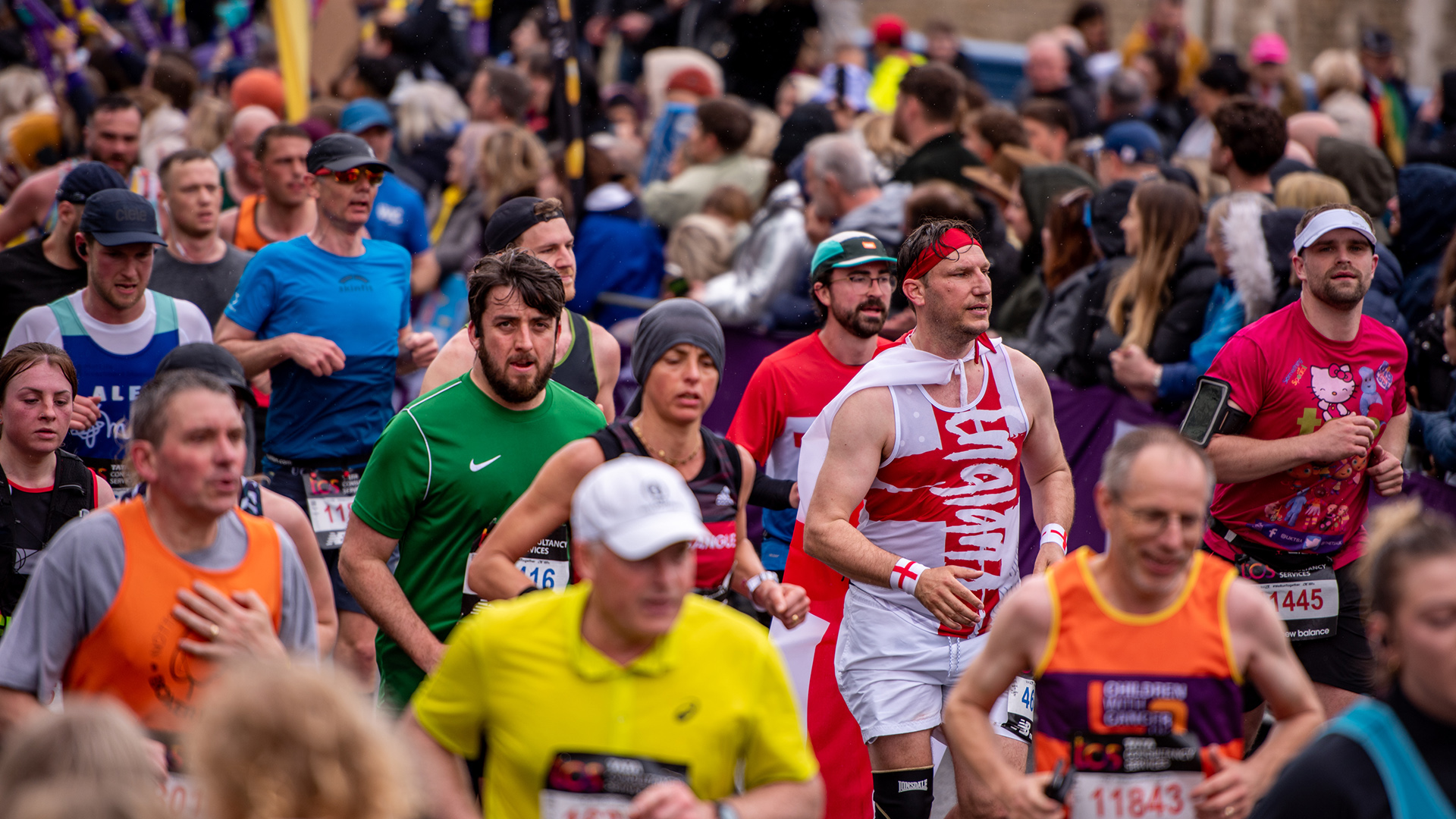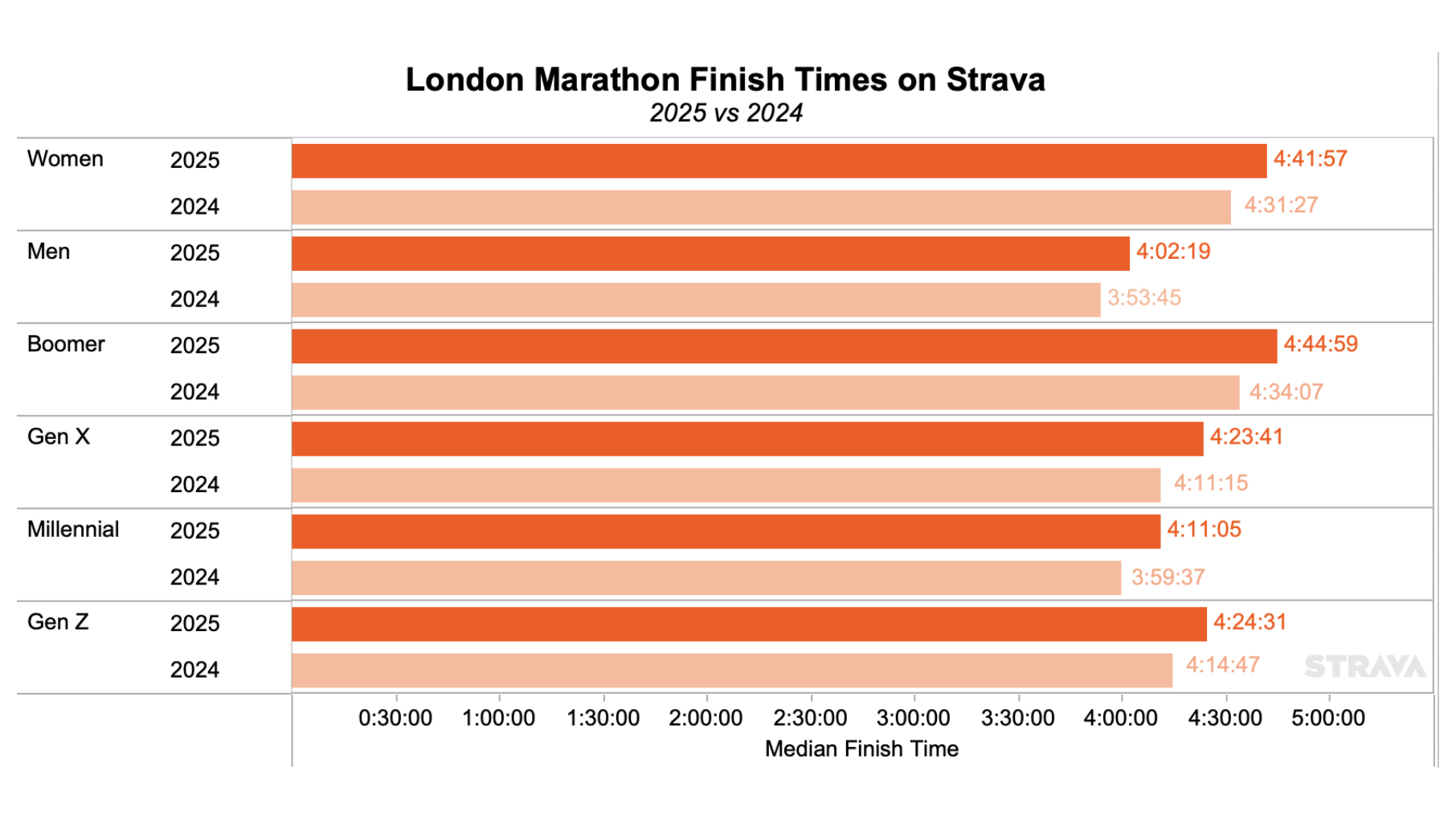This year's London Marathon finishers were way slower than last year – Strava data reveals 6 possible reasons
It’s official: runners at the 2025 London Marathon were slower than last year, and not just by a little


According to new data from Strava, the go-to app for runners, cyclists and millions of other athletes, average finish times for the London Marathon across every gender and generation dropped noticeably in 2025 compared to 2024.
From Gen Z to Boomers, women to men, everyone crossed the line a little later this time around; in some cases, more than ten minutes slower on average.
Strava, which tracked uploads from more than 60% of 2024’s 54,000 finishers and is used by over 150 million athletes worldwide, has been keeping a close eye on how people prepare for (and perform in) one of the world’s biggest marathons.
The platform’s race-day and training insights offer a unique lens on the current state of running, and this year, they reveal a clear trend: 2025 runners simply didn’t keep pace.
Alongside the slower finish times, Strava reports that more than half of this year’s participants bonked, which a term for a 10% or greater drop in pace during the second half of the race, while the 5th kilometre was the fastest of the whole route. That suggests a lot of runners went out too hard and struggled to hold on.
So what happened? From weather and pacing errors to demographic shifts and training habits, here are six possible reasons why London Marathon 2025 turned out to be a slower slog for so many runners.
1. The weather wasn’t playing ball
Weather always plays a significant role, and the difference between the two years ' finish times exemplifies this.
Get all the latest news, reviews, deals and buying guides on gorgeous tech, home and active products from the T3 experts
In 2025, the race day began with temperatures around 10–11°C in the morning. As the day progressed, temperatures rose to approximately 22–23°C by mid-afternoon. While these conditions were pleasant for spectators, they posed challenges for runners, especially those on the course during the peak heat hours.
In contrast, the 2024 London Marathon experienced cooler temperatures, with highs around 12°C. These cooler conditions are generally more conducive to endurance running, allowing for better performance and reduced risk of overheating.

2. People went out too hard and paid for it
Strava says the 5th kilometre was the fastest of the race, with an average pace of 5:20/km. Add that to the fact that over 50% of runners 'bonked' (slowed down by 10% or more in the second half), and it’s clear that pacing strategies went out the window this year.
3. There were more first-timers and casual runners
The running boom is still going strong, with marathon participation up 14% over the past five years. That’s fantastic, but it may also mean a field with more newcomers, charity runners and people just aiming to finish, not race.

4. Gen Z and Boomers didn’t slow down as much, but Millennials and Gen X dropped HARD
In 2025, every generation slowed compared to 2024, but Millennials and Gen X had it worst, clocking 12 minutes slower median times. Boomers and Gen Z only dropped 10 minutes. Fatigue? Less training? Or maybe it was just a rough day for the 30–50 crowd.
5. People trained solo and it hurt them on race day
According to Strava, runners who trained with others were significantly less likely to bonk (29% vs 45%). With social running and club participation up 64% in the UK last year, it’s clear that those who tapped into group energy had the edge.
6. Cross-training works, but maybe people skipped it this time
In 2024, 62% of finishers cross-trained, mostly with cycling and weights. Strava hasn’t confirmed this year’s cross-training stats yet, but if that number dipped, it could explain the fade in performance and late-race fatigue.

Whatever the reason, one thing’s clear: 2025 wasn’t a PB year for most. Between the warmer weather, over-ambitious pacing, and changing runner habits, it was a tough day out for thousands pounding the streets of London.
But hey, slower times don't mean less heart. The marathon is still a massive achievement, and there's always next year to chase that sub-4. Maybe not at the London Marathon with its 2% success rate of getting in due to overapplication, but there are plenty of other long-distance races to choose from.

Matt Kollat is a journalist and content creator who works for T3.com and its magazine counterpart as an Active Editor. His areas of expertise include wearables, drones, fitness equipment, nutrition and outdoor gear. He joined T3 in 2019. His byline appears in several publications, including Techradar and Fit&Well, and more. Matt also collaborated with other content creators (e.g. Garage Gym Reviews) and judged many awards, such as the European Specialist Sports Nutrition Alliance's ESSNawards. When he isn't working out, running or cycling, you'll find him roaming the countryside and trying out new podcasting and content creation equipment.
You must confirm your public display name before commenting
Please logout and then login again, you will then be prompted to enter your display name.